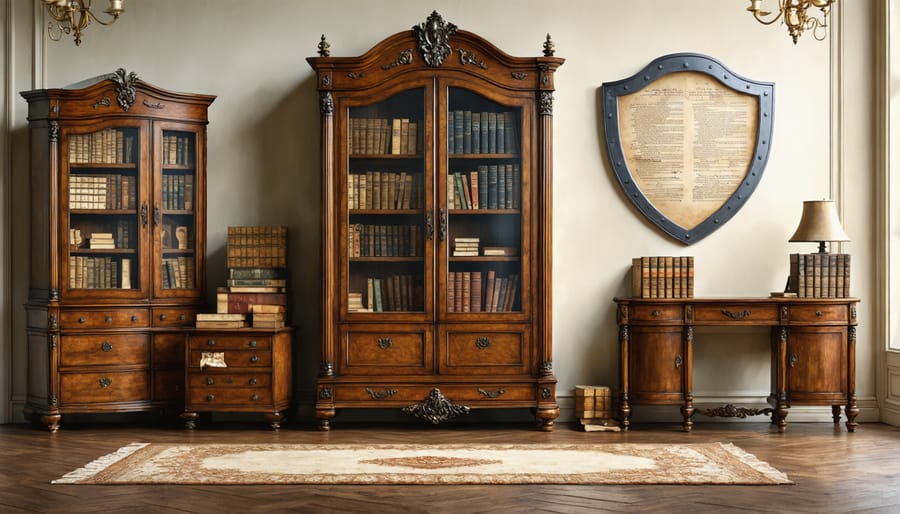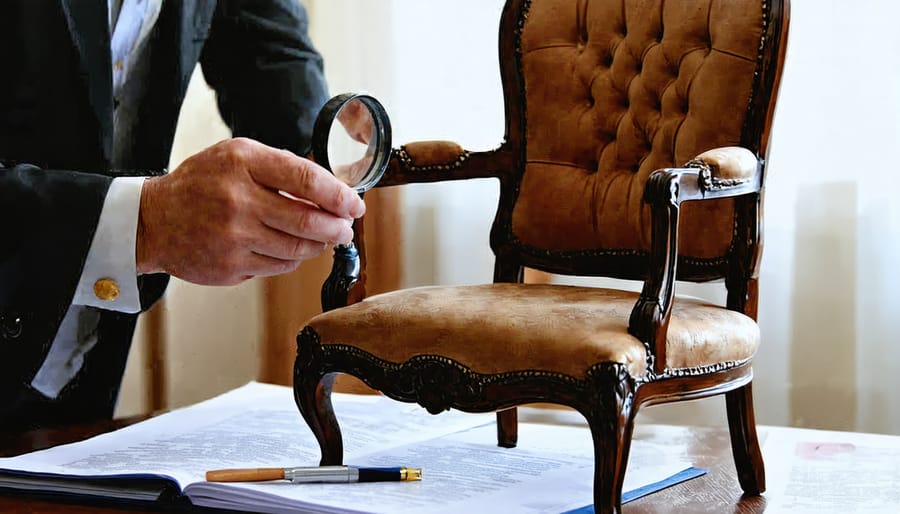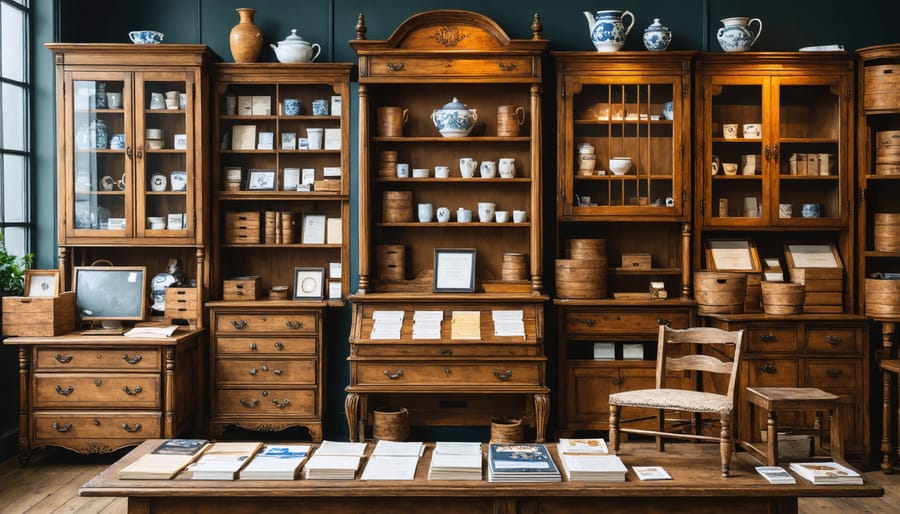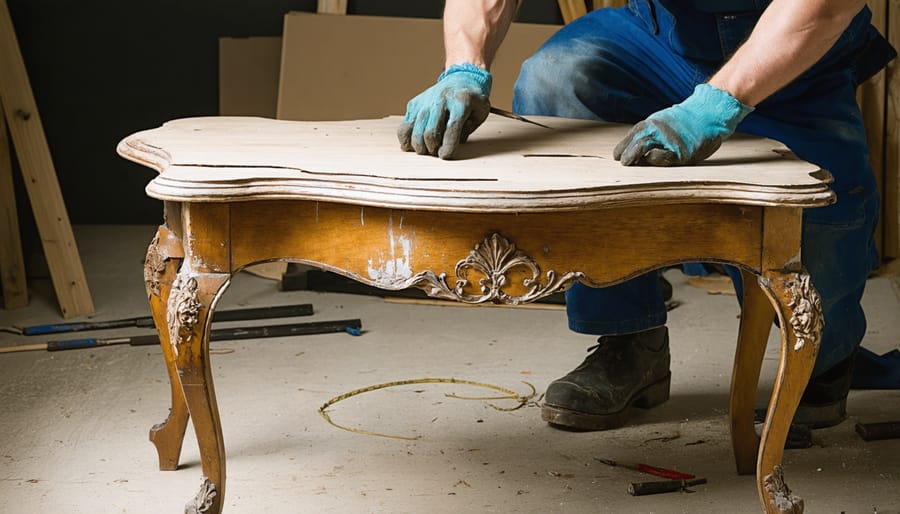
Protecting your antique treasures demands more specialized insurance coverage than standard homeowner’s policies provide. Whether you’re safeguarding a Victorian armoire worth $50,000 or an entire collection of 18th-century furnishings, proper insurance coverage specifically designed for antiques can mean the difference between full compensation and devastating financial loss.
Expert appraisals, detailed documentation, and specialized riders form the foundation of effective antique insurance protection. Professional appraisers evaluate not just current market values but also factor in historical significance, provenance, and potential appreciation – critical elements that standard insurance policies often overlook. Regular updates to these appraisals ensure your coverage keeps pace with your collection’s evolving value.
Leading insurance providers now offer tailored policies that address unique risks facing antique owners – from improper restoration attempts to damage during transit. These specialized policies typically cover authentication disputes, market value fluctuations, and even the cost of working with expert conservators should damage occur.
For collectors and enthusiasts, securing proper insurance isn’t just about protecting financial investments – it’s about preserving irreplaceable pieces of history for future generations. Understanding your coverage options and working with insurers who specialize in antiques provides essential peace of mind while maintaining your collection’s legacy.
While standard homeowners insurance provides basic coverage for personal property, the limitations of home insurance often fall short when it comes to protecting valuable antiques. Most standard policies cap coverage for individual items and may not account for an antique’s true market value or appreciate its historical significance.
Specialized antique coverage, on the other hand, offers distinct advantages designed specifically for collectors and owners of valuable pieces. These policies typically provide agreed-value coverage, meaning you and your insurer determine the item’s worth upfront, ensuring you receive the full value in case of loss or damage. They also often include coverage for depreciation, restoration costs, and even appreciation in value over time.
Key benefits of specialized coverage include:
– Protection during transit and temporary storage
– Coverage for gradual deterioration and environmental damage
– Lower deductibles for valuable items
– Access to specialized appraisers and restoration experts
– Coverage for pairs and sets
Consider this: A standard policy might value your 18th-century armoire at its functional replacement cost, while specialized coverage ensures its true historical and market value is protected. For collections valued over $10,000, specialized coverage becomes particularly important to bridge the gap between basic insurance and comprehensive protection of your antique investments.
For valuable antique furniture pieces, standard insurance policies often fall short of providing adequate coverage. This is where riders and floaters come into play – specialized insurance add-ons that offer enhanced protection for your cherished antiques.
A rider, also known as an endorsement, modifies your existing homeowner’s policy to provide additional coverage for specific items. For antique furniture, riders typically offer protection against a broader range of risks and may cover the full appraised value rather than just the replacement cost.
Floaters, on the other hand, are separate policies that “float” alongside your primary insurance. These are particularly valuable for high-worth antiques as they offer comprehensive coverage, including protection during transit, at shows, or while being restored. Floaters usually cover losses that standard policies exclude, such as accidental damage, mysterious disappearance, or loss during shipping.
When selecting a rider or floater for your antiques, consider:
– Regular professional appraisals to ensure accurate coverage
– Documentation of condition and value
– Geographic coverage limitations
– Deductible options
– Claims process requirements
Most insurance providers recommend updating your riders or floaters annually to reflect any changes in your collection’s value. Working with an insurance agent who specializes in antiques can help you choose the most appropriate coverage options for your specific pieces and circumstances.

Professional appraisals are essential for ensuring your antique pieces are adequately insured and protected. A professional appraiser brings expertise in determining not just the current market value of your antiques, but also their historical significance, rarity, and authenticity. This detailed evaluation forms the foundation of your insurance coverage and can be invaluable during claims processes.
When seeking an appraisal, look for certified professionals who specialize in antique furniture and decorative arts. These experts should be members of recognized organizations such as the International Society of Appraisers (ISA) or the Appraisers Association of America (AAA). A thorough appraisal typically includes detailed photographs, measurements, condition reports, and documentation of any unique characteristics or markings.
Most insurance companies recommend getting your antiques reappraised every three to five years, as market values can fluctuate significantly. Some factors that influence value changes include market trends, restoration work, or newly discovered historical information about the piece. Regular appraisals help ensure your coverage remains appropriate and up-to-date.
During the appraisal process, the expert will:
– Examine the piece’s construction and materials
– Verify authenticity and age
– Document any existing damage or repairs
– Research comparable sales
– Provide a detailed written report
– Include replacement value estimates
Keep all appraisal documentation in a secure location and provide copies to your insurance provider. This documentation proves invaluable when filing claims or updating your coverage. Many insurers require recent appraisals before writing specialized coverage for high-value antiques, making professional valuations an essential step in protecting your investment.
Creating a comprehensive inventory of your antique collection is crucial for insurance purposes and requires careful attention to detail. Start by photographing each piece from multiple angles, including close-ups of unique features, maker’s marks, and any existing damage. These photos should be high-resolution and well-lit to document antique damage effectively and showcase the item’s condition.
Next, compile detailed written descriptions for each piece, including:
– Dimensions and materials used
– Age and period of manufacture
– Maker or manufacturer information
– Provenance and purchase history
– Unique identifying characteristics
– Current condition assessment
– Professional appraisal value
Obtain professional appraisals from certified experts who specialize in your type of antiques. These appraisals should be updated every 3-5 years to reflect current market values. Keep all original receipts, certificates of authenticity, and previous appraisal documents in a secure location, with digital copies stored in cloud storage.
Create a spreadsheet or digital inventory management system that includes all this information, along with inventory numbers assigned to each piece. Consider adding small, removable identification tags to your pieces that correspond to your inventory system.
Remember to document any restoration work or repairs performed on your antiques, including dates, costs, and the professionals who completed the work. This documentation helps establish the piece’s maintenance history and can support insurance claims if needed.
Store your inventory documentation in multiple secure locations, including off-site storage or a bank safety deposit box, to ensure you can access this vital information even if your home experiences damage or loss.

When disaster strikes and your antique furniture sustains damage, taking immediate action can significantly impact your insurance claim’s success and the potential for restoration. First, document the damage thoroughly with clear, well-lit photographs from multiple angles, including close-ups of affected areas and wider shots showing the piece in its environment.
Secure any broken or loose pieces and store them safely – even small fragments can be crucial for restoration. If water damage is involved, carefully dry the piece using soft, clean cloths, but avoid applying heat or direct sunlight, which can cause further damage.
Contact your insurance provider immediately to report the incident and initiate the claims process. Many policies require prompt notification, and delays could affect your coverage. While waiting for an adjuster, protect the piece from further damage by moving it to a safe, climate-controlled location if possible.
Create a detailed written account of the incident while it’s fresh in your memory, including the date, time, and circumstances of the damage. Gather any relevant documentation, such as original purchase receipts, previous appraisals, or restoration records. If the damage resulted from a broader incident like a fire or flood, obtain copies of any official reports.
Remember not to attempt any repairs before the insurance adjuster’s assessment, as this could complicate your claim or void your coverage.
Working with insurance adjusters requires preparation, documentation, and clear communication to effectively protect your antique investments. Start by gathering detailed photographs, professional appraisals, and any documentation of the item’s history and provenance before meeting with your adjuster. These materials will help establish the true value of your pieces and support your claim.
When meeting with your adjuster, maintain a professional yet collaborative approach. Be prepared to explain what makes each piece valuable, including its age, craftsmanship, and historical significance. Remember that many adjusters may not be antique specialists, so clearly communicating these aspects is crucial to maximize your insurance claim.
Keep detailed notes of all conversations and get any agreements in writing. If you disagree with the adjuster’s assessment, don’t hesitate to request a second opinion from an independent appraiser specializing in antiques. Most insurance policies allow for this, and it can make a significant difference in the final settlement.
Consider inviting the adjuster to meet with your antique dealer or restoration specialist who can provide expert insights about the piece’s value and condition. This professional perspective often helps adjusters better understand the unique characteristics and worth of your antiques, leading to more accurate valuations and fair settlements.
Professional restoration services play a crucial role in the insurance claims process for antique furniture. When damage occurs to valuable pieces, insurance companies often rely on expert restorers to assess the extent of damage and determine the most appropriate restoration approach. The professional restoration process not only helps validate claims but also ensures that antiques are restored to their original condition while preserving their historical and monetary value.
These specialists work closely with insurance adjusters to provide detailed documentation, including condition reports, restoration plans, and cost estimates. Their expertise helps determine whether a piece can be restored or requires replacement, which directly impacts claim settlements. Professional restorers also maintain detailed photographic evidence of their work, creating before-and-after documentation that supports the claims process.
Quality restoration services can often save insurance companies significant amounts compared to replacement costs, especially for rare or historically significant pieces. Moreover, professional restorers understand the importance of using period-appropriate materials and techniques, ensuring that any repairs maintain the piece’s authenticity and value.
For antique owners, working with certified restoration professionals approved by their insurance provider helps streamline the claims process and provides peace of mind that their cherished pieces are in capable hands. These experts can also offer valuable advice on preventive measures to protect antiques from future damage.

Protecting your antique furniture through proper insurance coverage is not just a precautionary measure – it’s an essential investment in preserving both financial and historical value. Throughout this guide, we’ve explored the critical aspects of insuring antique pieces, from understanding different coverage options to documenting your collection and navigating the claims process.
Remember that standard homeowner’s insurance policies often fall short when it comes to protecting valuable antiques. The unique nature of these pieces demands specialized coverage that accounts for appreciation, restoration costs, and accurate market valuations. Working with insurers who understand the antique market and can provide agreed-value policies gives you the confidence that your treasured pieces are properly protected.
Documentation remains your strongest ally in protecting your investment. Maintain detailed records, including professional appraisals, photographs, and provenance documentation. Regular updates to your inventory and valuations ensure your coverage keeps pace with market changes and your collection’s growth.
When selecting insurance coverage, consider factors beyond just monetary value. Look for policies that offer flexibility in choosing restoration specialists, coverage for items in transit, and protection against various types of damage specific to antique furniture. The right insurance partner should understand both the financial and historical significance of your pieces.
Taking proactive steps now can save significant stress and financial loss later. Schedule regular reviews of your coverage, stay informed about market values, and maintain open communication with your insurance provider about any changes to your collection. Remember that protecting antique furniture isn’t just about preserving monetary worth – it’s about safeguarding pieces of history for future generations.
By implementing the strategies and considerations outlined in this guide, you’re well-equipped to make informed decisions about protecting your antique furniture collection through appropriate insurance coverage. Your investment in proper insurance today ensures the legacy of your antiques remains secure for years to come.